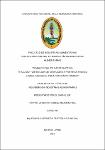Obtención de kamaboko a partir de Fasaco (Hoplias malabaricus), para consumo humano
Abstract
El presente trabajo de investigación tuvo como objetivo obtener Kamaboko a
partir del Fasaco (Hoplias malabaricus), determinar la temperatura y tiempo de
tratamiento térmico óptimo del Kamaboko.
Determinar la formulación óptima del Kamaboko a partir del Hoplias
malabaricus (Fasaco), evaluar sensorialmente el producto terminado como son:
el color, sabor, olor, apariencia y textura.
En este trabajo se utilizó el método científico experimental.
En cuanto a los análisis fisicoquímicos se emplearon métodos de la A.O.A.C., en
cuanto a los análisis microbiológicos se emplearon métodos de I.C.M.S.F.
Los resultados de los análisis fisicoquímicos de la carne del Fasaco fueron los
siguientes: Humedad 75.62%, Cenizas 1.84%, Proteínas 19.75%, Grasas 0.46%,
Carbohidratos 2.87%, Calcio 118.16 mg., los resultados de los análisis
fisicoquímicos del producto final (Kamaboko) son los siguientes: Humedad
67.67%, Cenizas 3.93%, Grasas 0.33%, Proteínas 26.85%, Carbohidratos 1.22%,
Cloruros 3.51%, Solidos Totales 32.33%, Calorías 115.25 Kcal.
Los resultados de los análisis microbiológicos del producto final fueron los
siguientes: Aerobios Mesofilos 10 x 101, Escherichia coli <3, Staphylococcus
aureus <10, Salmonella sp. Ausencia en 25g.
Los resultados de los análisis sensoriales del producto final en cuanto al color,
olor, sabor, apariencia y textura son de buenos, siendo el tratamiento más
adecuado el número 2 (T2), y el atributo más representativo la Apariencia.
Los resultados de la prueba de aceptabilidad del producto final por parte de los
consumidores potenciales al preguntar ¿Qué tal le pareció el producto? 71% de
encuestados respondieron Me gusta mucho. Al preguntar ¿Si tuviera la
oportunidad de comprar el producto lo compraría? Sí respondieron 68%. Al
preguntar ¿Si conociera Ud. Los beneficios del Kamaboko Lo compraría? Sí
respondieron 75%. y contrastando con los resultados fisicoquímicos y
microbiológicos se llegó a la conclusión de que este producto (Kamaboko)
cumple con todos los requisitos indispensables para ser apto para el consumo
humano. This research was carried out as a objective to obtain Kamaboko from Fasaco fish (Hoplias malabaricus) to test the temperature and time in the perfect and thermal treatment of Kamaboko.
Testing the suitable representation of Kamaboko from Fasaco (Hoplias malabaricus) where the product is tested sensory according to the color, taste, smell, appearance and texture. This research employed the experimental scientific method.
Regarding the physiochemical analysis, it was used methods from A.O.A.C., in the same way microbiological analysis was used methods from I.C.M.S.F. The results of physiochemical analysis about Fasaco´s meat were the following : Humidity 75.62%,ashes 1.84%,proteins 19.75%, fats 0.46%, carbohydrates 2.87%,calcium 118.16 mg. Considering the final product of the results of physiochemical analysis about Kamaboko we obtained: Humidity 67.67%, ashes 3.93%, fats 0.33%, proteins 26.85%, carbohydrates 1.22%,chlorides 3.51 % ,solid in general 32.33%,calories 115.25 kcal. The results of microbiological analysis about the final product were the following: mesophilic aerobic 10 x 101, Escherichia coli <3, Staphylococcus aureus <10, Salmonella sp, getting absence in 25g.
The results of sensory analysis of the final product about the color, smell, taste, appearance and texture are good, the most suitable treatment is the number 2 (T2), and the most representative item is the appearance.
As a result of acceptability test about the final product, a survey was made potential consumers with the question: What do you think about the product? 71% of them answered: I like it very much. With the question: and if they had the chance to buy the product? 68% of them would buy it. Another question was: if you knew the benefits of Kamaboko, would you buy it? 75% of surveyed people responded yes. Making a contrast between physiochemical and microbiological results we conclude that Kamaboko has all of essential requirements to be suitable for human use.
Collections
- Tesis [122]
The following license files are associated with this item:


